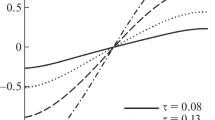Summary
Following A. V.Hill, those formulae are developed in a mathematical research which are of interest in the field of physiological diffusion processes in cylindrical objects.
At first, an introduction into the problem is given. Then a development follows of the mathematical methods (Bernoulli's method [Produktansatz],Laplace-transformation) which are suitable for the integration of the partial differential equation of the diffusion.
The special part contains the investigation of problems which are importance for the physiology of respiration. Thus the query is answered for the concentration of a substance in dependance of time and place for the diffusion in tissue cylinders taking into consideration a constant rate of consumption, as well as the query of the temporal alteration of the average concentration. The cylinder fed from the outside and the one fed from a central capillary (Krogh's) must hereby be specially treated according to the boundary conditions. The developed equations are explained by special examples and numerical lists. Further, the steady state of supply of tissue cylinders is investigated in case that apart from the radial also an axial diffusion component (Längsdiffusion) has to be counted with. The numerical results from the developed formulae are in good agreement with the values found by experiments.
Résumé
Suivant A. V.Hill on a développé dans une étude mathématique les formules qui se rapportent aux procédés de diffusion dans la physiologie.
Pour l'introduction, on donne une explication des problèmes. Puis on fait suivre le développement mathématique (méthode de l'intégration deBernoulli, transformationLaplace) qui permettent l'intégration de l'équation différentielle de la diffusion.
Dans la partie spéciale, on étudie des problèmes concrets de la physiologie respiratoire. Pour la diffusion dans des cylindres cellulaires on a trouvé le résultat de la concentration d'une substance en dépendance du lieu et du temps où on a tenu compte à une consommation constante. De même, on a réussi a résoudre le problème du changement temporel de la concentration moyenne. Il est nécessaire de traiter en particulier le cylindre dans des conditions spéciales c'est-à-dire quand il est approvisionné du dehors et d'un tube capillaire et central (cylindreKrogh). On a expliqué les équations différentielles par des cas spéciaux et par des tableaux numériques. Puis on a étudié la provisionnement stationnaire des cylindres cellulaires en cas que outre la composante de diffusion radiale, il faut tenir compte à une composante de diffusion axiale (Längsdiffusion). Les résultats obtenus par les formules développées correspondent bien aux valeurs trouvées par les expériences.
Similar content being viewed by others
Literaturverzeichnis
Davies, P. &D. W. Bronk (1942). Rapid bursts of oxygen consumption in stimulated muscie. - Rev. Sci. Instruments XIII, p. 524–533.
Doetsch, G. (1950). Handbuch derLaplace-Transformationen. - Basel, Birkhäuser, 581 p.
Doetsch, G. &D. Voelker (1950). Die zweidimensionalenLaplace-Transformationen. - Basel, Birkhäuser, 259 p.
Elliot, K. A. C. &M. Henry (1946). Metabolism of brain suspensions. IV. Respiration at low oxygen tension.- J. biol. Chem. CLXIII, p. 351–374.
Hill, A. V. (1928). The diffusion of oxygen and lactic acid through tissues. - Proc. roy Soc., B, CIV, p. 39–96.
Hill, D. K. (1948). Oxygen tension and the respiration of resting frog's muscle. - J. Physiol. CVII, p. 479–495.
Jacobs, M. H. (1935). Diffusionprocesses. - Ergebn. Biol. XII, p. 1–60.
Jahnke, E. &F. Emde (1948). Tafeln höherer Funktionen. - Leipzig, Teubner, 300 p. (spez. S. 125 u.f.).
Kreuzer, F. (1950). Ueber die Gültigkeit desFick'schen Gesetzes bei der Diffusion des Sauerstoffes in dünne Schichten hochkonzentrierter Hämoglobinlösungen. Diss., Zürich-Fribourg. - Hergiswil a. See, 54 p.
— (1951). Ueber die Diffusion des Sauerstoffs durch Erythrozytensuspensionen verschiedener Konzentration in Ringer-Lösung. - Helv. physiol. pharmacol. Acta IX, p. 185–195.
Krogh, A. (1929). Anatomie und Physiologie der Kapillaren. 2. Aufl. - Berlin, Springer, 353 P.
Lense, J. (1947). Reihenentwicklungen in der mathematischen Physik. - Berlin, de Gruyter, 226 p. (Spez. p. 55 u.f.).
Opitz, E. &M. Schneider (1950). Ueber die Sauerstoffversorgung des Gehirns und den Mechanismus der Mangelwirkungen. - Ergebn. Biol. XLVI, p. 125–260.
Opitz, E. &G. Thews (1952). Einfluss von Frequenz und Faserdicke auf die Sauerstoffversorgung des menschlichen Herzmuskels. - Arch. Kreislaufforsch. XVIII, P. 137–152.
Sommerfeld, A. (1947). Partielle Differentialgleichungen der Physik. - Leipzig, Akad. Verlagsges., 332 p. (Spez. p. 85 u.f.).
Warburg, O. &F. Kubowitz (1929). Atmung bei sehr kleinen Sauerstoffdrucken. - Biochem. Z. CCXIV, p. 5–19.
Winzler, R. J. (1941). The respiration of bakers yeast at low oxygen tension. - J. cell. comp. Physiol. XVII, p. 263–276.
Author information
Authors and Affiliations
Additional information
Mit Unterstützung durch Mittel der Deutschen Forschungsgemeinschaft.
Rights and permissions
About this article
Cite this article
Thews, G. Über die mathematische Behandlung physiologischer Diffusionsprozesse in zylinderförmigen Objekten. Acta Biotheor 10, 105–138 (1953). https://doi.org/10.1007/BF01556093
Received:
Issue Date:
DOI: https://doi.org/10.1007/BF01556093




